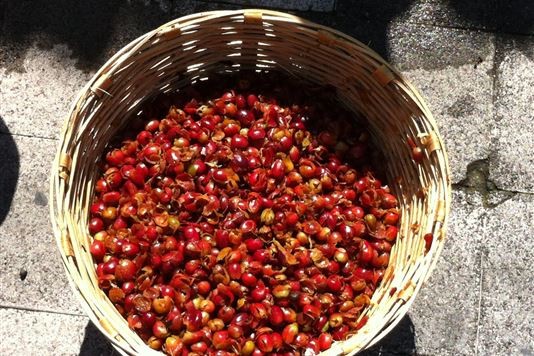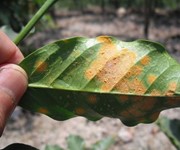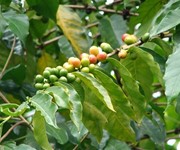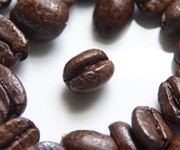How a new type of flour could save impoverished coffee farmers

Lots of people start their day with a cup of coffee. But who knew that the coffee plant also held an untapped resource of food?
That cherry-red substance in the main image above is called coffee pulp. It's a simple by-product of the coffee industry that's usually thrown away. But now a group of clever entrepreneurs are turning it into 'coffee flour', which is perfect for baking. I've found about a bit more about this up-and-coming sustainable ingredient.
Coffee farming
There are roughly 25 million smallholders producing over 80% of the world’s coffee in more than 70 countries. These coffee-producing countries earned $23.5 billion (around £13.97 billion) from exporting coffee in 2011.
But the global coffee market was worth three times that – $70.86 billion (£42.1 billion) – in the same year, demonstrating the direction in which profits are skewed. The Fairtrade Foundation estimates that coffee growers receive just 7-10% of the retail price of coffee in payment.
Growing pains
 Life as a coffee farmer is tough. The little money that they do earn tends to go on housing, education and medical care (plus the cost of feeding their families), meaning that most farmers teeter on the edge of poverty. This problem is only exacerbated when uncontrollable factors like extreme weather cause a poor harvest, or market speculation drives the value of coffee down.
Life as a coffee farmer is tough. The little money that they do earn tends to go on housing, education and medical care (plus the cost of feeding their families), meaning that most farmers teeter on the edge of poverty. This problem is only exacerbated when uncontrollable factors like extreme weather cause a poor harvest, or market speculation drives the value of coffee down.
Worse still, coffee rust might strike (pictured left). The fungus hemileia vastatrix is the cause of this disease, which can be devastating to coffee plantations. Infected trees develop small spots of yellow on their leaves, which expand and turn orange-red, hence the ‘rust’ moniker.
Infected leaves drop prematurely, stripping branches of leaves and reducing yields, and can even lead to the death of the trees. There are very few places left in the world that coffee rust has not reached.
Flour power
When growers pick their crop, they harvest the ripe coffee cherries, discarding the pulp surrounding the coffee bean before collecting the beans for processing.
But a new company has had a brilliant idea with potential to change the lives and fortunes of farmers: why not do something useful with the pulp?
Andrew Fedak, co-founder of The Coffee Flour Company, says: "It's common for farmers to eat cherries as they pick, but our research indicates coffee flour represents the first instance of the cherries being dried and milled as a food ingredient.”

Coffee flour (pictured above) is exactly what it sounds like: coffee cherries are processed into a new kind of flour that has been tested and proven to work when making pasta dough, granola, breads, cookies, and plenty more besides.
Right now, the method of converting the cherries into coffee flour is being kept a secret, because certain elements of the process are protected in patent applications.
And it should also be noted that coffee rust may still affect this venture too.
The taste
Describing taste is tricky, but Andrew first makes it clear that coffee flour does not taste like coffee. "It has a tart profile, like roasted fruit," he says, but it is also "quite unique. Some have compared it to plum or tobacco flower."
Economic profits
 However, coffee flour does need to be mixed with another type of flour for cooking. In fact, coffee flour should only make up between 5-20% of your overall flour measure. "Pushing to 20% in breads can result in some texture issues," says Andrew. "The cellulosic nature of the material requires additional moisture when baking."
However, coffee flour does need to be mixed with another type of flour for cooking. In fact, coffee flour should only make up between 5-20% of your overall flour measure. "Pushing to 20% in breads can result in some texture issues," says Andrew. "The cellulosic nature of the material requires additional moisture when baking."
Perhaps it’s best, then, to consider the flour as a supplement to cooking with wheat, corn or other all-purpose flours. But as an additional source of revenue for the farmers, it’s invaluable. Being able to sell something that was once just thrown away will provide them with another income stream, and sustainable jobs will be created from this new industry. When harvests are poor, this could give farmers and their families the extra money they need to see them through tough times.
Health benefits
 Coffee flour does contain caffeine. Aren’t people going to be bouncing off the walls after eating a pasta dish containing it?
Coffee flour does contain caffeine. Aren’t people going to be bouncing off the walls after eating a pasta dish containing it?
According to Andrew, my fears are ill-founded. The Coffee Flour Company will be “transparent” about the amount of caffeine in the flour, he says, although that amount will vary. But “the serving sizes... are such that the caffeine levels should not present a problem.”
Moreover, coffee flour contains five times as much fibre as whole grain wheat flour, 84% less fat and 42% more fibre than coconut flour, three times as much protein and iron per gram than fresh kale and fresh spinach respectively, and 1oz of coffee flour has double the amount of potassium as a banana.
Environmental advantages
Coffee cherry pulp is often dumped into rivers or left to rot in heaps. When it’s ditched into bodies of water, eutrophication can occur. This is where the water becomes oxygen deprived due to the decomposition of the plant matter, leading to an abundance of algae or plankton (which is sometimes called a ‘bloom’). These organisms then use up too much oxygen in the water, leading to a state called ‘hypoxia’, or an aquatic environment with too little oxygen to sustain life.
Research from 2011 found that the quality of water downstream from coffee processing plants had significantly deteriorated as a result of the disposal of “untreated coffee waste into running water courses”. Dissolved oxygen (DO) in the rivers was less than 0.01mg/l during the coffee-processing season. No fish could survive in these conditions.
By using the pulp to make coffee flour instead of just dumping it, this problem could eventually be eradicated. Aquatic wildlife could re-populate currently uninhabitable waterways, re-establishing a natural food chain that is being disrupted by coffee processing.
The future
 The Coffee Flour Company now operates in Hawaii, Nicaragua, Guatemala, Mexico and Vietnam, and Andrew says there are plans already in motion to expand to more regions and build new mills.
The Coffee Flour Company now operates in Hawaii, Nicaragua, Guatemala, Mexico and Vietnam, and Andrew says there are plans already in motion to expand to more regions and build new mills.
These planned regions include vast swathes of Africa, South America and Asia. Take a look at the Coffee Flour Company website for more details and to learn more about this sustainable and eco-friendly product.
Do you think coffee flour sounds like a good idea? And would you like to give it a go in your baking? Talk to us in the Comments box below.
This article was updated on the 10th June 2014.
Coffee flour and discarded coffee cherries images courtesy of coffee flour™, coffee rust image courtesy of Smartse, coffea arabica image courtesy of Robert Knapp, coffee beans image courtesy of Forest and Kim Starr.
You might also like:
Kitchen test: best coffee makers
Comments
Be the first to comment
Do you want to comment on this article? You need to be signed in for this feature